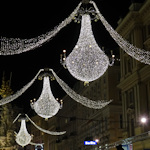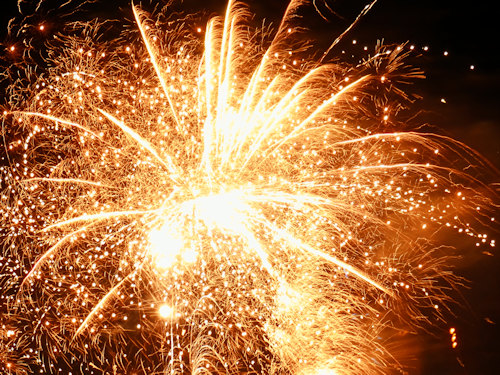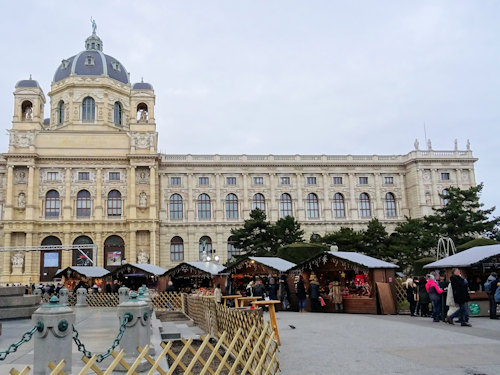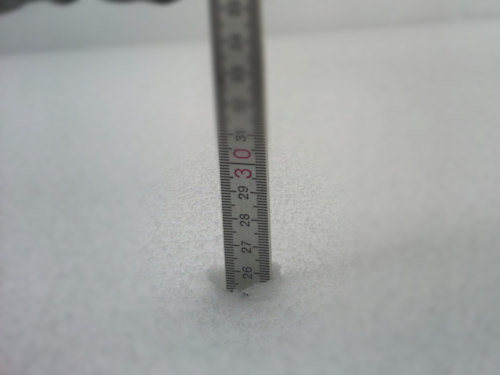
Time to swap Christmas baubles for palace balls, punch for sparkling wine, and sausages for…nope, keep the sausages. It’s New Year’s Eve in Vienna.
Discover the delights of December 31st in Austria’s capital, what to expect at the New Year markets and any official city celebrations, plus local tips on getting the most out of your year-end trip. Warning: may include waltzes.
- Book a concert experience* for your Vienna trip
- See also:
Jump to:
- How local’s celebrate
- The Silvesterpfad entertainment trail
- New Year markets
- New Year events
- Expected weather
- Seasonal public transport
- Useful phrases
We begin with how the locals welcome in the New Year…
Celebrating New Year’s Eve

(Waltz your way along the Graben street in the centre below giant chandeliers)
The German word for New Year’s Eve in Austria is Silvester. The term comes from the same-named pope and saint, who died on December 31st, AD 335. None of which has any relevance, though, to how Vienna celebrates the turn of the year.
People party just like the rest of the world. Aside from parties, though, Vienna has one or two little traditions not shared by such cities as New York, London or Tokyo.
In the hour before midnight on New Year’s Eve, for example, the main national TV station plays Dinner for One, a short comedy sketch recorded in 1963 (in English!).
At midnight itself, the giant Pummerin bell of Vienna’s St Stephen’s cathedral rings in the New Year with the chimes simultaneously broadcast across TV and radio.
Once the last echoes of the Pummerin fade away, firework displays across the city burst into action.
Broadcasters then switch to the Blue Danube waltz and everyone dances in the New Year as lights explode across the night sky.
Then, just to add that special touch of romance to the evening, we all swap marzipan pigs.
Seriously.
Our porcine friends count as lucky charms here. Although life as a pig in Austria might be considered less than fortuitous given the locals eat pork in vast quantities: see the Schnitzel.

(Expect lots of this at midnight)
The firework shows make quite a sight, leaving Vienna a smoky haze redolent with the smell of gunpowder (possibly just my overwrought imagination).
Actually, we seem to have fewer and fewer fireworks each year as people and organisations switch to less noisy alternatives for welcoming the New Year. The official city display in 2023, for example, was a laser show.
To get a good view of the lights over the city, head up into the hills. Alternatively, find your way to a place known for great views of Vienna (at least those that open late at night). Inevitably, you’ll need to reserve a place/seat at the commercial locations and book well in advance.
(Read more about Vienna’s New Year traditions.)
The Silvesterpfad
As far as parties go, the city itself has its own grand version enjoyed by hundreds of thousands of people: New Year’s Eve in Vienna is all about the Silvesterpfad, which translates literally as the “New Year’s Eve trail”.
The name covers a series of interlinked stages put up throughout the centre. Over 800,000 people celebrated along the Silvesterpfad in December 2023.
In 2024, expect the fun to begin at 2pm on December 31st and run through to 2am on January 1st, 2025.

(One of the stages at a previous Silvesterpfad)
Live singers, bands, orchestras, and DJs on the Silvesterpfad stages entertain everyone until midnight and beyond. Dozens of food stands ensure you don’t go hungry or thirsty.
A lot of the route still features the Christmas lights, which remain on though the New Year and into early January. These include the giant chandeliers hanging along the Graben (the pedestrianised zone leading away from Stephansdom); a ballroom dancing school usually offers public waltz courses below them.
Finally, at midnight, people gather on Stephansplatz square in front of the cathedral to hear the Pummerin’s midnight chimes.
In most years, folk also assemble on the Rathausplatz square in front of the Rathaus (town hall) at the same time for a waltz and communal midnight light display.
(Read more about Vienna’s Silvesterpfad.)
New Year markets

(The Silvesterdorf New Year market on Maria-Theresien-Platz)
Vienna is, of course, famous for its Christmas markets, but why stop there? Why indeed.
A couple of these markets morph into New Year alternatives (known by various German words, including Neujahrsmarkt, Silvestermarkt, and Silvesterdorf) from around December 27th.
At the best ones, you get all the sights, sounds, smells, and tastes that make the Christmas versions so popular, but without the nagging sense of guilt that you ought to buy a few presents while there.
Even after 25+ years in the city, I still love browsing these seasonal markets and enjoy a warming mug of Glühwein or similar.
I have a soft spot for the Schönbrunn Neujahrsmarkt. It’s a little away from the centre but has a bit more space than most seasonal markets. And the setting in the palace forecourt is magnificent.
(Read more about Vienna’s New Year markets.)
New Year events

(Franz Welser-Möst conducting the Wiener Philharmoniker at the 2023 concert; press photo © Wiener Philharmoniker / Dieter Nagl)
The big traditional event is the New Year’s Concert given by the world-famous Vienna Philharmonic Orchestra at the Musikverein. What few people know is they actually hold three concerts with the same programme:
- A “preview performance” on Dec 30
- A Silvesterkonzert on Dec 31
- The actual New Year’s Concert on Jan 1st
Good luck getting tickets for any of these. And I don’t mean that sarcastically: a lottery system decides who can buy a ticket. You need to register at a special page on the orchestra’s website much earlier in the year to have a chance.
You’d think tickets would be astronomically expensive and some are, but prices actually started from around €20 for the 2024 concert. Vienna has a strong tradition of ensuring access for (almost) anyone to cultural activities like opera, theatre and classical concerts.
(Read more about the New Year’s Concert and how to get tickets.)
A lot of hotels and prestigious locations host special Silvester gala evenings for the 31st, too. Prominent events include the gala at the Rathaus city hall. Venues like the Renaissance-style historical Kursalon put on additional seasonal concerts* for visitors alongside their usual offerings.
I should also mention the exhibitions, should you wish a dose of culture before the Pummerin chimes. The museums always pull out their best efforts for the end of the year.
Check the detailed suggestions for December and January. Around New Year 2024/2025, you can expect such highlights as:
- A Marc Chagall exhibition at the Albertina
- A rare Rembrandt exhibition at the Kunsthistorisches Museum
- A retrospective for Paul Gauguin at the Bank Austria Kunstforum Wien
The weather

(One day of snow back in the days before the climate crisis)
If you’re out and about at New Year, dress up warm. Obviously, nobody can say quite what the weather will be, but you’re on safe ground if you assume “cold”. Temperatures below 0°C are not unusual, especially late into the night.
Having said that, December 31st, 2021 broke heat records for the time of year and December 31st in 2022 and 2023 also felt unseasonably warm.
Public transport
On New Year’s Eve, public transport extends operations during the night.
The subway lines run at shorter intervals after midnight, only reverting to the normal nighttime schedule in the early hours. Many daytime tram lines and bus lines also operate into the night.
(Subway trains usually do not stop at Stephansplatz station from late evening because of the huge crowds on the Silvesterpfad.)
In 2025, January 1st is a public holiday; holiday travel in Vienna is usually better than many city’s normal timetables, frankly, so you needn’t worry about getting around on public transport.
Check locally, though, for full 2024/2025 arrangements.
Useful German phrases
Finally, to end this little guide, how about a couple of useful New Year phrases in German:
- Happy New Year / “guten Rutsch ins neue Jahr” (often shortened to just “guten Rutsch”)
- Sorry, I can’t hear you over the noise of the fireworks / “Ich kann Sie wegen der Kracher nicht hören”
- A marzipan pig. How delightful / “Ein Schwein aus Marzipan. Wie nett”
So…guten Rutsch!